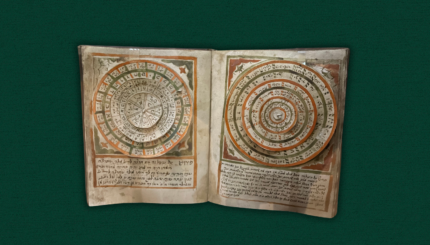Question: I live in an Orthodox neighborhood, and I see a lot of Orthodox men walking around with strings hanging out of their shirts. What are the strings, and why do only some of them have them?
–Jason, Chicago
Answer: The strings you see hanging out of their shirts are called tzitzit (sometimes pronounced tzitzis) and they are derived from the commandment in the Book of Numbers:
Speak to the Israelite people and instruct them to make for themselves fringes (tzitzit) on the corners of their garments throughout the ages. Let them attach a cord of blue to the fringe at each corner. That shall be your fringe; look at it and recall all the commandments of the Lord and observe them, so that you do not follow your heart and eyes in your lustful urge. (Numbers 15:38-39)
According to traditional Jewish law, one must have these tzitzit on every four-cornered garment one wears. However, today most clothing doesn’t have corners, so a special garment called a tallit is worn. A tallit has four corners with tzitzit on each corner. Many people have the custom of wearing the tallit only when they are praying, but others, particularly Orthodox Jews, wear a special small tallit, called a tallit katan, under their clothes. When they pray, they may wear an additional larger tallit over their clothes.
So when you see the strings hanging out, what you’re seeing are the tzitzit. And when Jews see the tzitzit, we’re meant to remember all of the commandments in the Torah, and remembering the commandments is meant to inspire us to avoid “lustful urges.” But you’re right that not all Orthodox men wear their tzitzit hanging out so they’re visible. Some men choose to tuck their tzitzit in. Why do some tuck them in, and some let them hang out?
With your help, My Jewish Learning can provide endless opportunities for learning, connection and discovery.
To some degree, this has to do with personal preference. Though many rabbinic authorities today advocate for men to wear their tzitzit hanging out to be a more obvious reminder, there are a number of rabbinic texts, going back to the Shulhan Arukh in the 16th century (Oreh Hayim 8:11), that allow for tzitzit to be tucked in, particularly if there’s a concern of anti-Semitism. The understanding is that the tzitzit will be untucked during the Shema prayer, when we read the lines from Numbers having to do with tzitzit, and that looking at the fringes then will be enough of a deterrent for lustful urges.
Some men choose to wear their tzitzit out, but tuck them into their pockets, or wrap them around their belts.
I asked Yeshivat Chovevei Torah rabbinical student Seth Winberg why he chooses to wear his tzitzit the way he does, and he said, “I wear my tzitzit tucked in. I feel immensely thankful to live in a time and place which affords me unprecedented religious freedom. I am not afraid to express my religious identity publicly. I wear a kippah, after all. I wear my tzitzit tucked in because I value appearing dignified to others. Letting my tzitzit hang out looks… shlumpy.”
In other words, some folks, like Seth, think that tzitzit hanging out looks messy, and tuck the tzitzit in to avoid appearing undignified. Others may not necessarily like the look of tzitzit hanging out, but are more stringent in observing the commandment and its exhortation to see the fringes. So there are different ways that people make the decision about whether to let their tzitzit hang out or not, taking into account both their personal taste (and even sense of fasion) and how their community interprets the specific commandment of tzitzit.
tallit
Pronounced: tah-LEET or TAH-liss, Origin: Hebrew, prayer shawl.
tzitzit
Pronounced: TZEET-tzeet, or TZIT-siss, Origin: Hebrew, fringes tied to the corners of a prayer shawl.
kippah
Pronounced: KEE-pah or kee-PAH, Origin: Hebrew, a small hat or head covering that Orthodox Jewish men wear every day, and that other Jews wear when studying, praying or entering a sacred space. Also known as a yarmulke.



